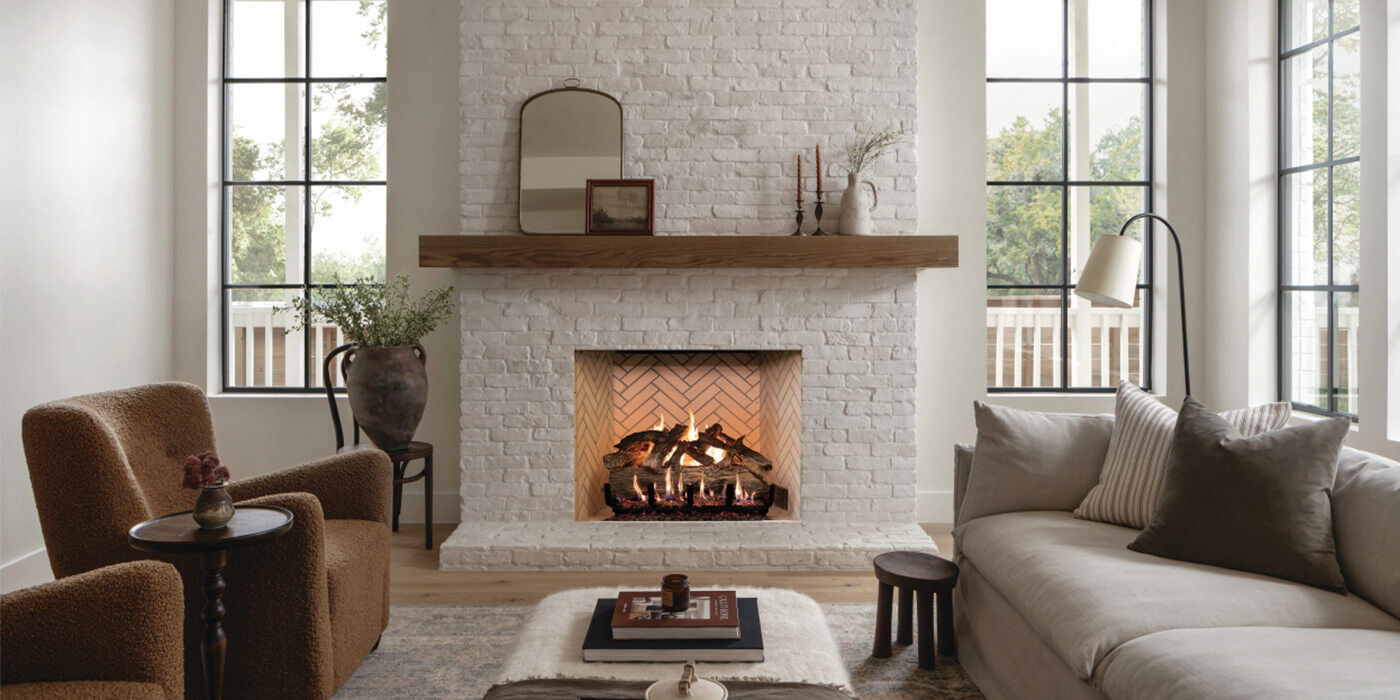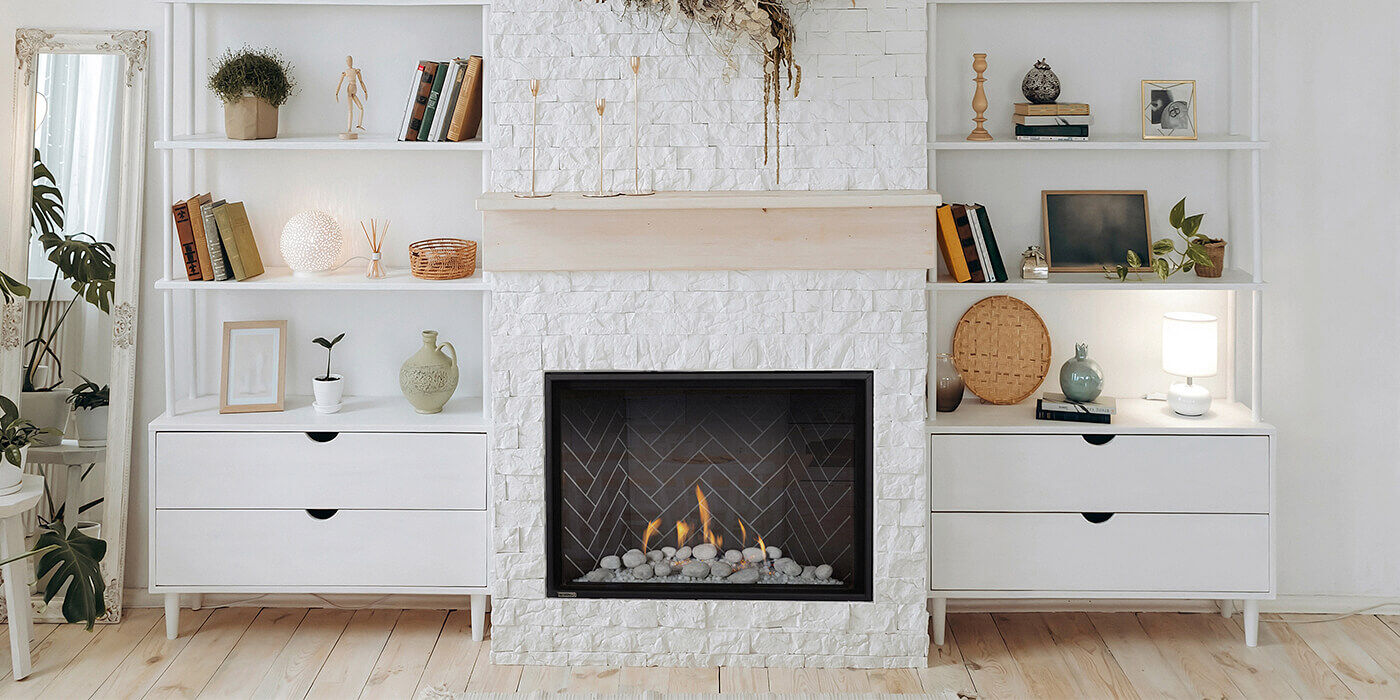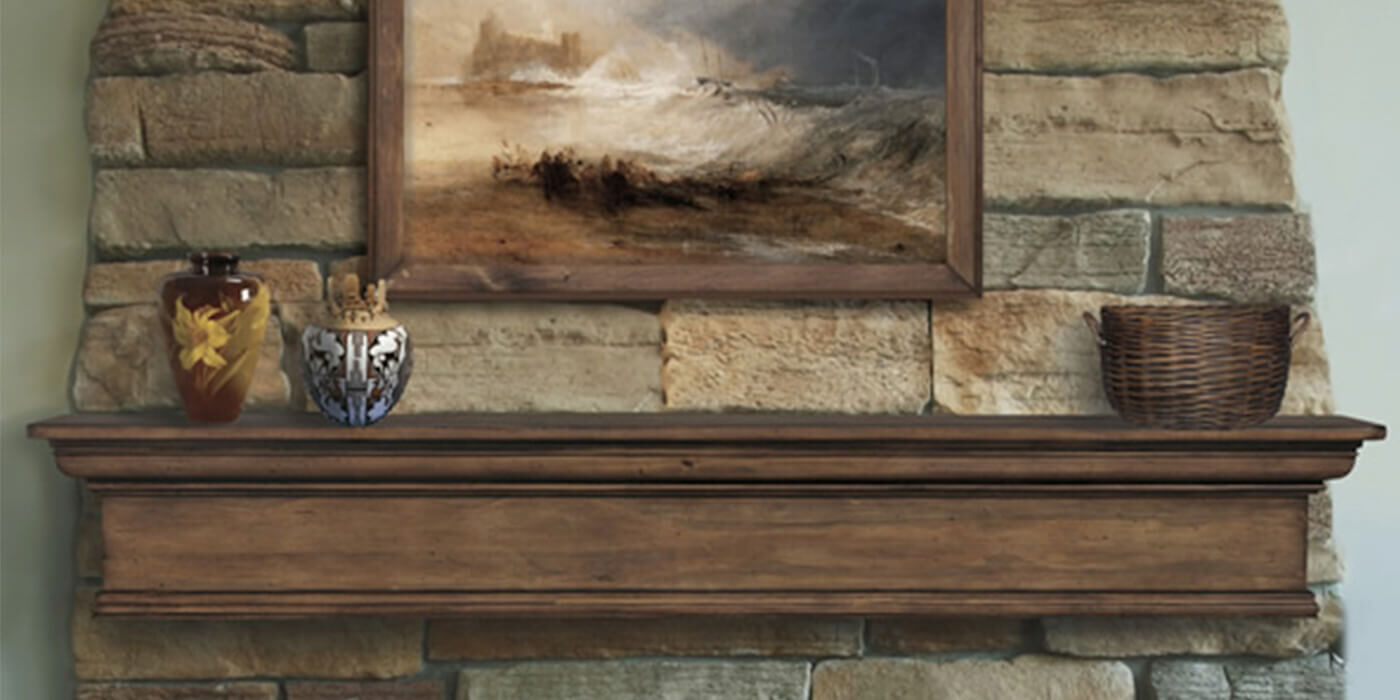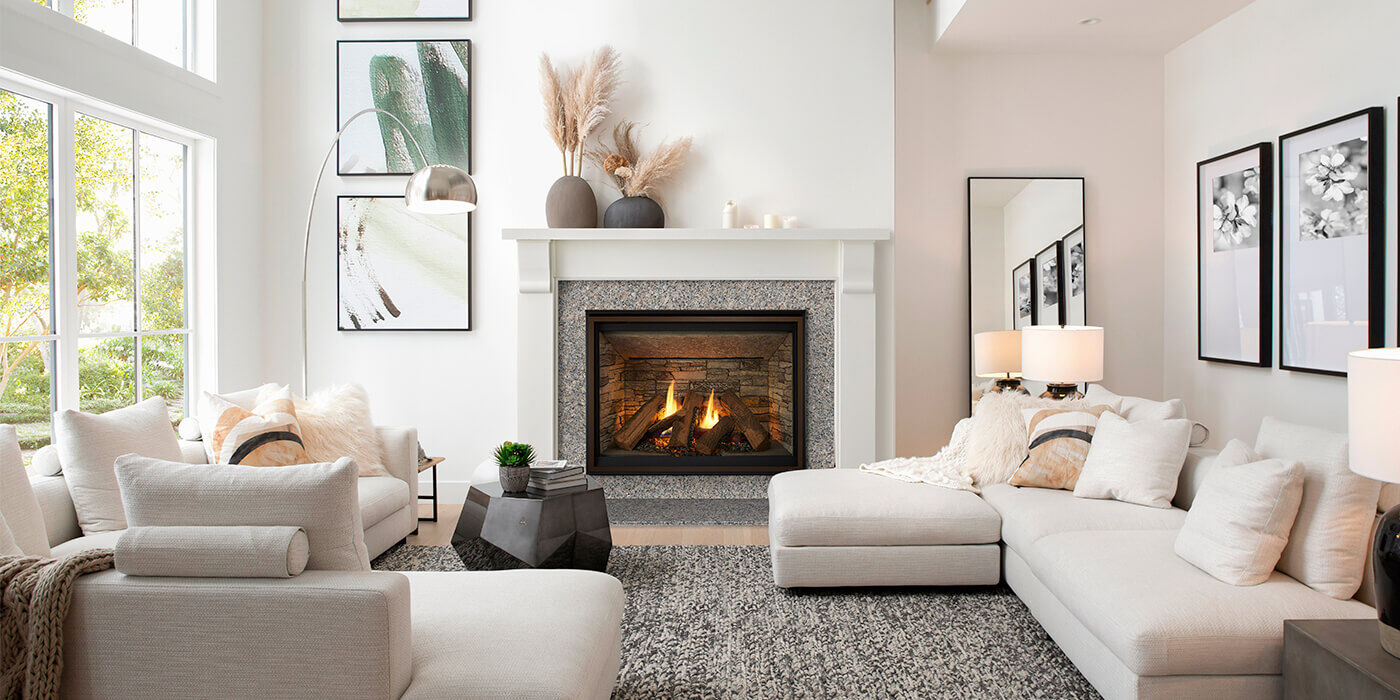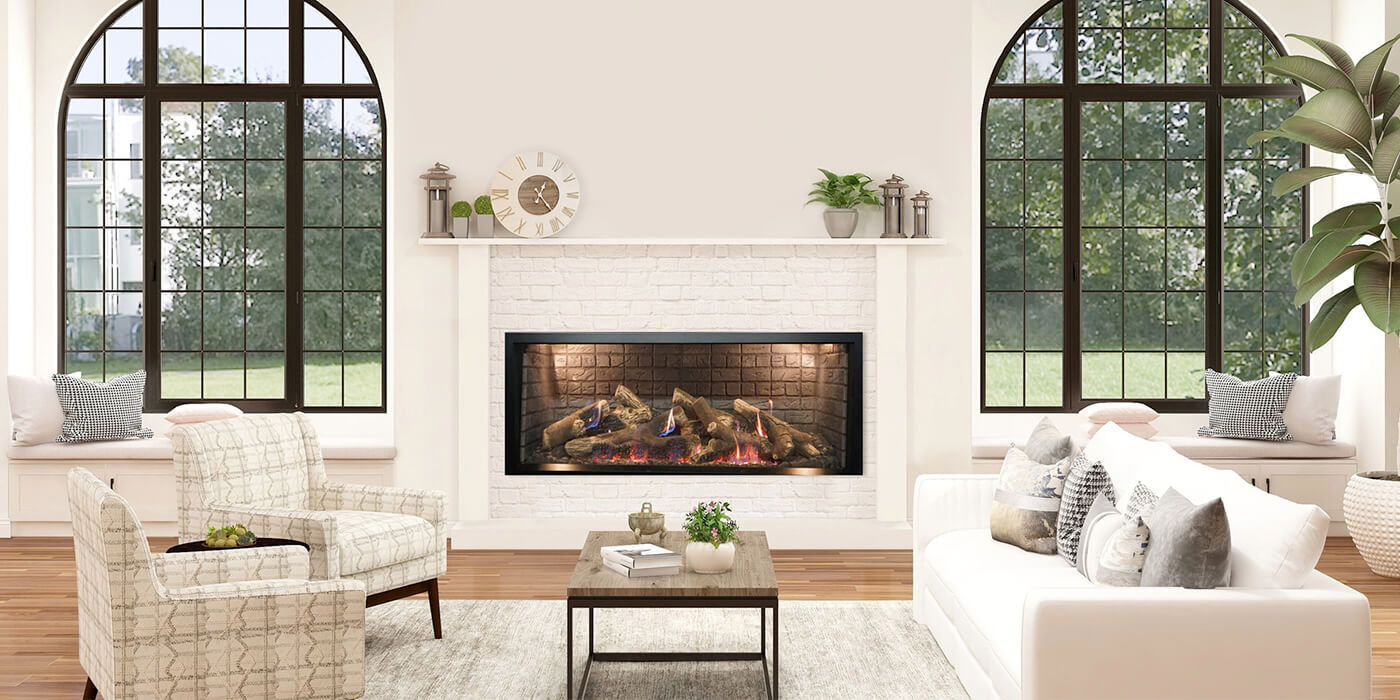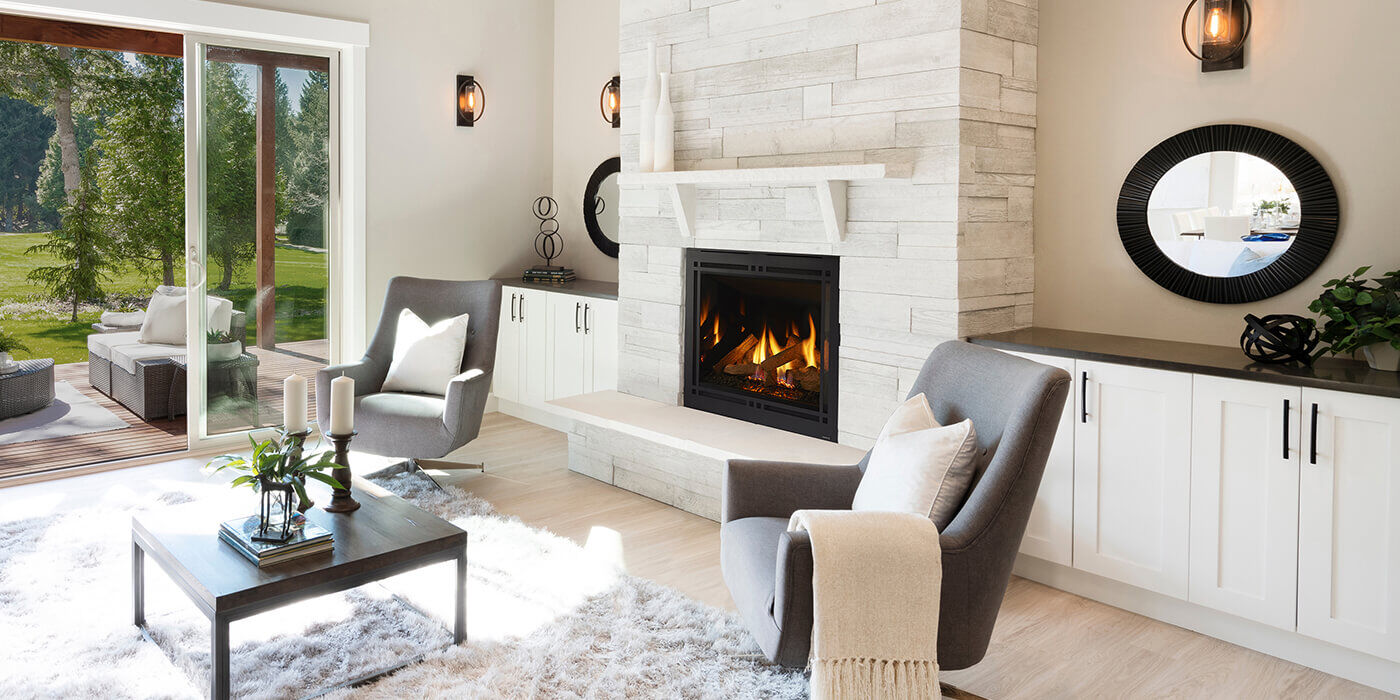By: Thomas Kearney, NFI Certified Master Hearth Professional
Last Updated: October 17, 2025
A well-chosen mantel can completely transform your gas fireplace design, creating the perfect centerpiece for your favorite place to unwind and entertain.
Whether you’re styling a new fireplace or refreshing an existing fireplace, the right mantel reflects your home’s personality. There are endless mantel options available today — from modern and minimalistic to traditional and timeless. It’s easier than ever to find a mantel shelf that complements your personal style and adds visual appeal to your living space.
In this ultimate guide, we’ll help you navigate styles, materials, and design tips to choose the perfect gas fireplace mantel for your home.
In This Article
Understanding Gas Fireplace Mantel Requirements
According to the U.S. Energy Information Administration, the demand for stylish gas fireplace installations continues to grow, with over 60% of households in the United States using natural gas for heating.
When installing or updating a gas fireplace, the mantel isn’t just a decorative element. Mantel requirements are designed to prevent excessive heat from damaging nearby materials and to reduce the risk of fire.
Every gas fireplace model has specific clearance guidelines that outline how far combustible materials, like wood mantels or trim, must be from the fireplace opening. These measurements are determined by the manufacturer and depend on factors such as the fireplace’s heat output, venting system, and design.
Always consult the owner’s manual or installation guide for exact specifications before adding or modifying a fireplace mantel.
Key Safety Considerations:
- Maintain proper clearance from the firebox opening to any combustible mantel material (clearance requirements are in the owner’s manual)
- Ensure proper ventilation around the mantel area
- Consider heat-resistant materials for areas closest to the fireplace
- Always consult manufacturer specifications for your specific gas fireplace model
Step 1 - Choosing the Material for your Mantel
Wood Mantels
Wood remains the most popular choice for gas fireplace mantels, offering warmth and versatility. Hardwoods like oak, maple, and cherry provide durability and beautiful grain patterns. Pine and poplar offer budget-friendly options that paint well.
- Benefits: Easy to customize, wide variety of finishes, classic appeal
- Considerations: Requires regular maintenance, potential for warping in high-heat areas
Stone and Marble Mantels
Natural stone creates an impressive, permanent installation that increases home value. Marble, limestone, and granite each offer unique characteristics and color variations.
- Benefits: Heat-resistant, low maintenance, luxury appearance
- Considerations: Higher cost, requires professional installation, limited design flexibility
Metal Mantels
Steel, iron, and aluminum mantels provide modern, minimalist appeal and exceptional durability. Powder-coated finishes resist heat and wear while offering countless color options.
- Benefits: Contemporary aesthetic, highly durable, excellent heat resistance
- Considerations: Can feel cold in traditional settings, may show fingerprints
Step 2 - Choosing the Perfect Color for Your Mantel
Neutral Foundation
Starting with neutral colors like white, cream, or natural wood tones creates a timeless backdrop that won't clash with changing décor trends.
According to a surveys, most homeowners prefer neutral fireplace surrounds for their long-term appeal.
Bold Statement Colors
Dark colors like charcoal, deep navy, or rich brown can create dramatic contrast and make the fireplace a commanding focal point.
This approach works particularly well in rooms with lighter wall colors.
Coordinated Color Schemes
Match your mantel to existing trim work or cabinetry for a cohesive, built-in appearance.
This strategy works especially well in open floor plans where the fireplace connects multiple living areas.
Step 3 - Choosing Your Fireplace Mantel Style
Traditional Styles
Classic mantel designs have incredible craftsmanship with detailed moldings, corbels, and proportioned profiles that complement traditional home architectures.
These styles work well with colonial, craftsman, and farmhouse design aesthetics.
Contemporary and Modern Styles
Clean lines, minimal ornamentation, and geometric shapes define modern mantel design.
Floating mantels and asymmetrical designs create visual interest without overwhelming the space.
Transitional Styles
Blending traditional and contemporary elements, transitional mantels offer the best of both worlds.
Simple profiles with subtle details appeal to a broad range of design preferences.
Step 4 - Sizing and Proportion Guidelines
Proper mantel sizing ensures your fireplace looks intentional and well-proportioned:
- Width: The mantel should extend 3-6 inches beyond each side of the fireplace opening
- Height: Position the mantel 54-60 inches from the floor for optimal visual balance
- Depth: A 6-8 inch depth provides adequate display space without overwhelming the room
Step 5 - Installation and Professional Considerations
While some homeowners tackle mantel installation as DIY projects, professional installation ensures safety compliance and optimal results.
Custom mantels with complex installations involving stone or integrated shelving systems typically require professional expertise.
DIY-Friendly Options:
- Floating wood shelves
- Simple bracket-mounted designs
- Lightweight materials
Professional Installation Recommended:
- Heavy stone or marble mantels
- Built-in entertainment centers
- Complex carpentry work
- Electrical integration for lighting
Maximizing Your Investment
A well-chosen mantel can increase your home's value significantly. Real estate professionals note that updated fireplaces, including attractive mantels, often yield returns of 75-85% of their installation cost during home sales.
According to Redfin on average, homes with fireplaces sell for about 13% more.
Value-Adding Features:
- Quality materials that complement home architecture
- Professional installation and finishing
- Integration with built-in storage or display areas
- Energy-efficient design considerations
Mantel Design Tips for Different Room Sizes
Small Rooms
Choose lighter colors and simpler profiles to avoid overwhelming the space. Floating mantels create the illusion of more room.
Large Rooms
Bold, substantial mantels can anchor large spaces effectively. Consider deeper profiles and dramatic materials like thick wood beams or substantial stone.
Open Floor Plans
Coordinate mantel design with other architectural elements visible from the fireplace area to maintain visual flow.
Maintenance and Longevity of Your Mantel
Different mantel materials require varying maintenance levels:
- Wood mantels need periodic refinishing and dusting
- Stone mantels require sealing every 1-2 years
- Metal mantels need occasional cleaning with appropriate products
Summary
Choosing the perfect fireplace mantel involves balancing aesthetics, safety, and functionality. Consider your home's architectural style, room proportions, and personal preferences when making material and design decisions. Remember that a thoughtfully selected mantel serves as both a design element and a valuable home improvement investment.
Whether you opt for the warmth of wood, the elegance of stone, or the sleek appeal of metal, ensure your choice complements your gas fireplace's efficiency and your home's interior design. With proper planning and consideration of these key factors, your new mantel will provide years of beauty and enjoyment.
FAQs
Most manufacturers require 6-12 inches of clearance from the firebox opening, but always check your specific model's installation manual as requirements vary significantly between Direct Vent, Vent-Free, and insert-style gas fireplaces.
Not all gas fireplaces are compatible with mantels. Some modern linear or see-through models aren't designed for traditional mantels. Check with your manufacturer before purchasing.
A mantel typically refers to the shelf portion, while a mantelpiece includes the entire surround structure including legs, header, and decorative elements.
Stone, marble, or built-in designs typically require professional installation. Simple floating wood shelves or lightweight brackets can often be DIY projects if you're comfortable with basic tools.
Yes, always turn off the gas supply and allow the fireplace to cool completely. Some installations may require temporary disconnection of gas lines, which requires a licensed professional.
We’re Here to Help
Do you have more questions about fireplace mantels? Reach out to our NFI Certified Master Hearth Professionals today at 800.919.1904.
More Resources
Not able to install a gas or wood burning fireplace? Today’s electric fireplaces offer realism, convenience, and safety.
Understand the differences between gas logs and gas fireplace inserts.
Is it safe to have a fireplace at your home? Sometimes, building codes and local restrictions come into play.
 |
Tom Kearney has been a Technical Sales Representative at Woodland Direct for over a decade, where he has honed his expertise in gas, wood, and pellet appliances as an NFI-Certified expert. Tom's dedication to customer satisfaction is exemplified by his work with high-profile clients, including assisting SpaceX President Gwynne Shotwell in sourcing five stunning fireplaces for her Texas home. When he's not helping clients find their perfect fireplace, Tom enjoys hitting the golf course, skiing down snowy slopes, and exploring new trails on his bike. Call him or one of our experts in fire at 800.919.1904. |
